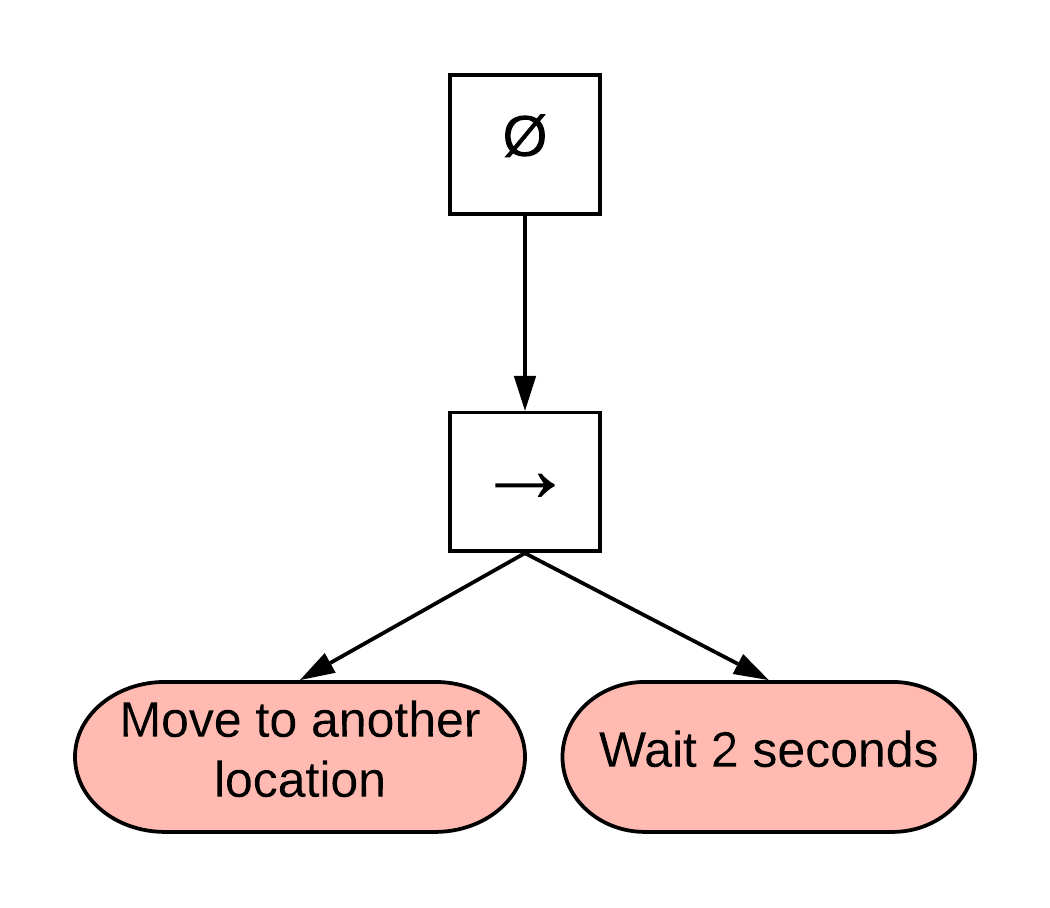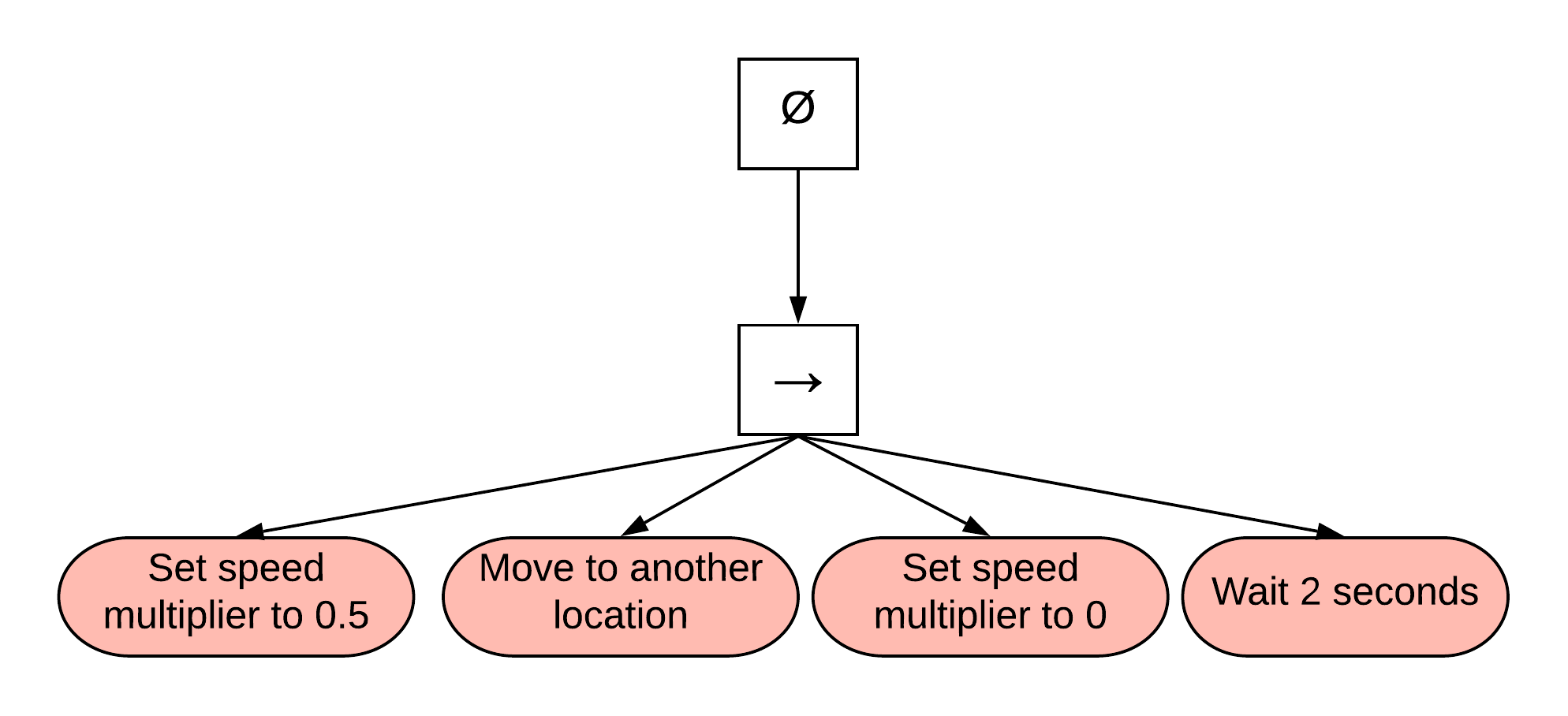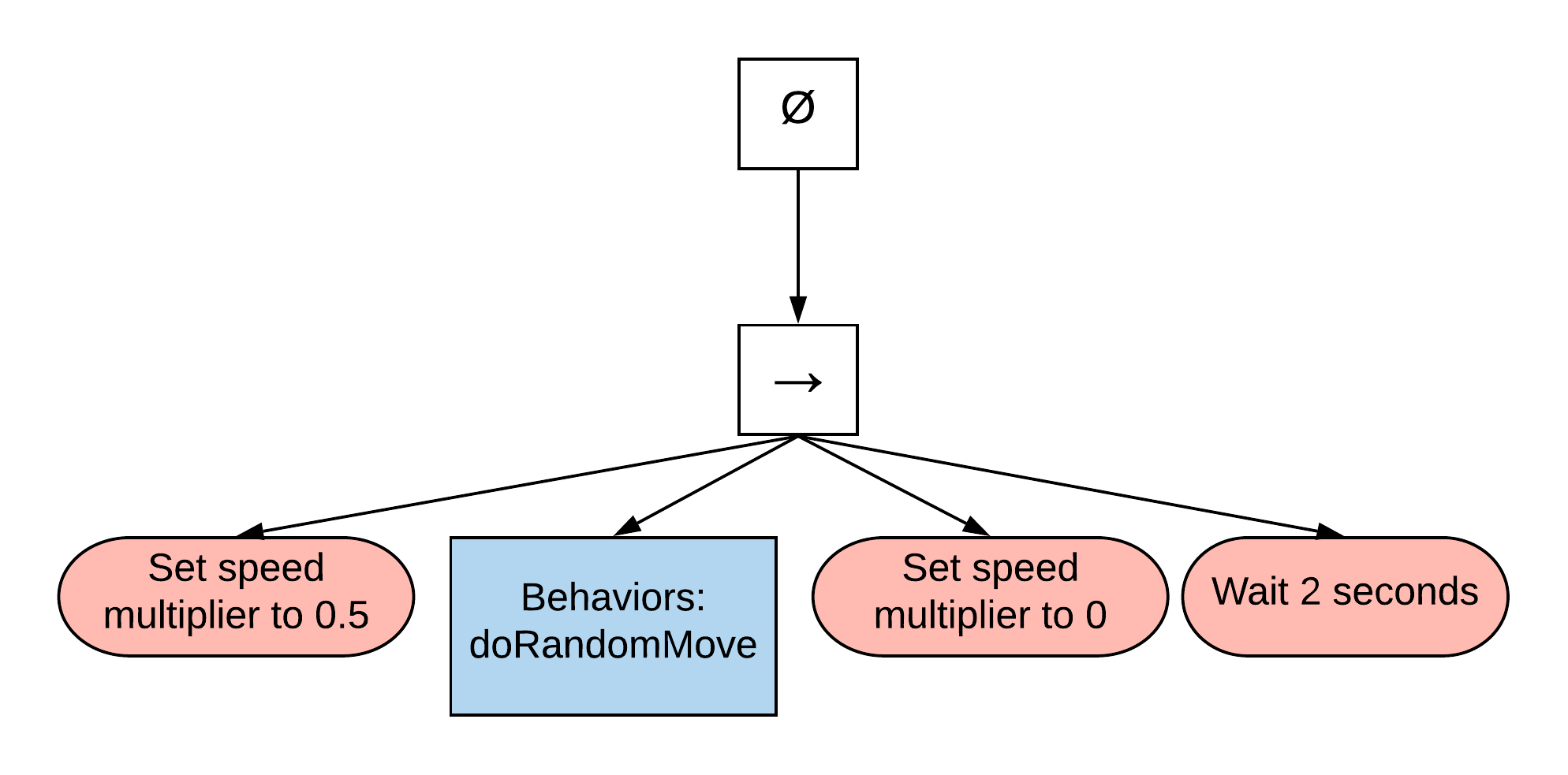-
Notifications
You must be signed in to change notification settings - Fork 18
Step By Step Tutorial
This page shows how to create a behavior from scratch. It is highly adviseable that you understand how Terasology's behavior system works - it is explained here.
If you are here, it means you want to assign a behavior to an entity or creature in the game. We will not cover the basics of creating a new creature - you can find more about this subject in this tutorial.
The first thing to do is to model what your creature is supposed to do. Let's say that you want your creature to do the following:
- Go from where it stands to another location;
- Stay at the new location for a couple of seconds;
- Do it gain.
You will (eventually) find that this is pretty much what the stray behavior does: the creture walks around the field, moving from one spot to another from time to time. Now - assuming that you already know about Terasology's behavior system, you also know that we will need to represent this behavior as a behavior tree. This is what it looks like:

The right arrow in the picture represents a sequence node, and the red containers represent the _ actions_ that will be executed. This is, of course, a very simplified view of our behavior tree. For example, let's assume that you are using a creature that already possesses a movement-related component, such as the ones you'll find in the Wild Animals module. In this case, in order to initiate/end the creature's movement, it is necessary to alter its speed: when the creature is moving, is possesses a speed greater than zero. Similarly, when the creature stops its speed is set to zero.
In the Wild Animals module the creature's movement can be controlled through the CharacterMovement component. Here's how it looks like in the creature's prefab (we are using the deer.prefab file as an example - you can find it in Wild Animals' asset folder):
"CharacterMovement" : {
"groundFriction" : 16,
"speedMultiplier" : 0.3,
"distanceBetweenFootsteps" : 0.2,
"distanceBetweenSwimStrokes" : 2.5,
"height" : 1.6,
"radius" : 0.3,
"jumpSpeed" : 12
}Observe that it contains a parameter called speedMultiplier. Modifying this parameter is how we can control the character's speed: if we set it to zero, the base speed of the creature is multiplied by zero (so it stops). If we set if to a value other than zero, the creature goes faster or slower, according to what we want to do. For now, let's just say that we need to get the creature to a speed greater than zero when it starts moving, and then back to zero when it stops. Now our behavior tree looks like this:

Observe that we have two different actions here:
- One action that changes the speed multiplier of the
CharacterMovementcomponent; and - One action that actually tells the creature to move from one place to another.
Part of the beauty of the beauty of using behavior trees is that you can reuse other existing behavior trees. To illustrate that - and for the sake of simplicity - let's reuse an existing behavior tree associated with the movement action. In the Behaviors module there is a behavior tree that does exactly that: moves the creature from a spot to a new, random one. This behavior tree is called doRandomMove. So let's use it - the only requisite is that the Behaviors module is listed as a dependency of the module you are currently working on (check the module development guide for more details on how to add dependencies in your modules). Your new behavior tree should look like this:

The blue box is the behavior tree that we are reusing from the Behaviors module.
Now that you already have your behavior tree, let's represent it using a .behavior file. In the module you are working on, go to the assets/behaviors folder and create a file called basicStray.behavior. For a quick reference, you can find more details on the structure of a .behavior file here. Open the newly created file in any text editor and - using the proper semantics - translate it to the used JSON-like format. After editing, your file should look like this:
{
sequence : [
{
change_speed : { speedMultiplier: 0.5 }
},
{
lookup: { tree: "Behaviors:doRandomMove" }
}
},
{
change_speed : { speedMultiplier: 0 }
},
{
sleep : {
time : 2
}
}
]
}...and that's about it - you have a new behavior. Don't forget to include it in your creature's prefab:
"Behavior" : {
"tree" : "<your-module>:basicStray"
}It is true that the behavior file was already created - but what should you do about the actual, well, actions? In the case of moving the creature we used an existing behavior tree, which uses actions that are already implemented, etc. But there's still the matter of changing the speed multiplier in the CharacterMovement component.
You can find more about developing within the Terasology envinronment here - but for now, we only need to create an action. After setting up your development environment:
- Go to your source package folder;
- Create a sub-package (sub-folder) called
actions; - Create a new class called
ChangeSpeedAction.
If you created your module using groovyw (or if you are modifying an existing module), you should have something like:

We won't go through all the development points of an action - you can check existing examples in different modules. However, here are a few important points:
- Any action must extend the
BaseActionclass, overriding themodifymethod to retorn the appropriate behavior state after its execution. - The
BehaviorActionannotation specifies the action name referred in the.behaviorfile. Tehy must be one and the same, otherwise you will get a compilation error. - Any action parameters used in the
.behaviorfile must be declared as a private field in the class implementation.
With that in mind, here's a simple implementation of the action changeSpeed:
@BehaviorAction(name = "change_speed")
public class ChangeSpeedAction extends BaseAction {
private float speedMultiplier;
@Override
public void construct(Actor actor) {
if(actor.hasComponent(CharacterMovementComponent.class)) {
EntityRef entityRef = actor.getEntity();
CharacterMovementComponent characterMovementComponent = entityRef.getComponent(CharacterMovementComponent.class);
characterMovementComponent.speedMultiplier = speedMultiplier;
entityRef.saveComponent(characterMovementComponent);
}
}
@Override
public BehaviorState modify(Actor actor, BehaviorState result) {
return BehaviorState.SUCCESS;
}
}For more examples of behaviors used in modules, please check our curated list.